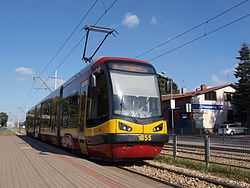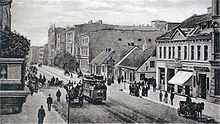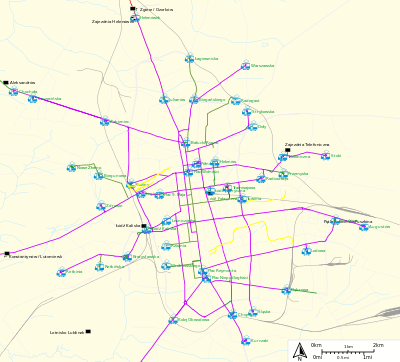Trams in Łódź
 | |
| Overview | |
|---|---|
| Native name | Tramwaje w Łodzi |
| Locale | Łódź, Poland |
| Transit type | Tram |
| Number of lines | 17 (excl. regional, seasonal and tourist lines) |
| Number of stations | 230 |
| Annual ridership | ~60 million |
| Operation | |
| Began operation | 1898 |
| Technical | |
| Track gauge | 1,000 mm (3 ft 3 3⁄8 in) |
Trams in Łódź made their first appearance on 23 December 1898. Łódź was the first city to have electric trams in what was then Congress Poland. Initially, there were two fairly short tram lines that both served the city centre area; by February 1899 their number was doubled. Two years later, the first suburban tram lines started – the Pabianice and Zgierz lubes. Both of these initiatives were the result of the activities of private companies in which German manufacturers dominated.
In the years 1910-1931 suburban tram lines connected many important places around the city, creating the largest such network in Poland, which remained unchanged until the end of the 1980s. In the first half of the 1990s, some of them were closed down, but the process has since been halted, leaving Łódź the only city in the country to still have such a system of commuter trams.
After World War II, the network of suburban and urban trams was nationalized and transferred to the Municipal Communication Company of Łódź (MPK), which, as the city of Łódź expanded, expanded the number and length of both urban and suburban lines. Currently MKP operates 16 urban and 4 regional (or suburban) lines. The longest of these, and in fact the longest of all of Poland, is number 46, which has a length of 38 kilometres (24 mi).
The system is characterized by narrow gauge (1,000 mm (3 ft 3 3⁄8 in) metre gauge) track. On tramline 10, modern Cityrunner trams run; yet the short distance between stops prevents them from reaching full speed. Currently, the routes of lines 11 and 46 are being upgraded under the Łódź Regional Tram project.
History

Łódź in the 1890s already had over 300 000 inhabitants. It was a large industrial city, characterized by textile industry. Yet it lacked a good public transport system. Especially around Piotrkowska Street the situation was dire; one thousand cabs and carriages drove around the city centre. Both the city government and local industrialists wanted to relieve this situation, and therefore took up the construction of a tram past the city centre. The first attempt was to build a horse tram, which ended in a failure; large stables would be needed in the center of the city, and for hygienic reasons, horse trams were then abandoned. A project with electric trams was then started, which would carry passengers by day, and cargo by night. The Electric Railway Consortium Lodz (KEL) won a tender for construction the line. Julius Kunitzer signed the contract in St. Petersburg in front of Nicholas II on behalf of the KEL. He was backed by the German company AEG, which then started construction in the summer of 1897. The first trams started on Friday, 23 December 1898.
The experiment with electric trams in Łódź fared even better than expected. It quickly paid off the cost of line construction, and the project brought considerable profits to its shareholders, whereas traffic in the center of the city clearly decreased. Additionally, the population, despite earlier serious concerns, quickly got used to trams 'running without a horse'.
While Łódź is acknowledged to be the first city in Poland to have a fully electrified tram system, it is less well known that unusually Łódź once boasted a small cemetery where tram drivers were buried. Sadly, nothing remains of this graveyard, which was situated on Lindley Street near the aptly named Tram Street (ul. Tramwajowa). Today, the cemetery plot where old tram drivers would have been laid to rest is occupied by the Lodz University Press and a language school.
Lines

- 1: Chojny – Strykowska
- 2: Dąbrowa – Szczecińska
- 3: Augustów – Wycieczkowa
- 4: Dąbrowa – Helenówek
- 5: Kurczaki – Wycieczkowa
- 6: Kurczaki – Strykowska
- 7: Koziny – Śląska
- 8: Augustów – Chochoła
- 9: Augustów – Zdrowie
- 10: Wyszyńskiego – Augustów
- 11: Chocianowice-IKEA – Helenówek
- 12: Wyszyńskiego – Stoki
- 13: Śląska – Szczecińska
- 14: Dąbrowa – Wyszyńskiego
- 15: Kurczaki – Telefoniczna
- 16A: Kurczaki – Helenówek
- 46A: Chocianowice-IKEA – Helenówek
Regional lines:
- 16: Kurczaki – Zgierz, Plac Kilińskiego (Jan Kiliński Square)
- 41: Chocianowice – Pabianice
- 43: Stoki – Lutomiersk
- 43bis: Stoki – Konstantynów Łódzki
- 46: Chocianowice-IKEA – Ozorków
Types of vehicles
MPK Łódź:
| Tramway type | Number |
|---|---|
| PESA 122N | 10 |
| Konstal 805N Elin | 16 |
| Konstal 805Na | 433 |
| Cityrunner | 15 |
| total | 474 |
Międzygminna Komunikacja Tramwajowa (MKT):
| Tramway type | Number |
|---|---|
| Konstal 803N | 14 |
| Düwag GT8 | 12 |
| Düwag GT8N | 6 |
| Düwag GT6 | 3 |
| Düwag M6S | 2 |
| Lohner GT6 | 1 |
| total | 38 |
Tramwaje Podmiejskie (TP):
| Tramway type | Number |
|---|---|
| Konstal 803N | 11 |
| Düwag GT6 | 10 |
| Düwag M8S | 1 |
| total | 22 |
External links
| ||||||||||||
